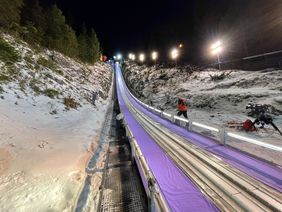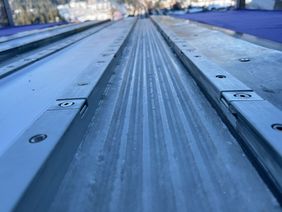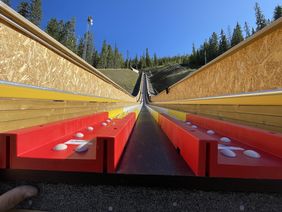The current situation is anything but easy for jumping hill operators. The energy costs for snow production, lighting, operating costs, cooling, etc. are skyrocketing. Heads are spinning in order to handle training and competition in an economically profitable manner.
A not inconsiderable part of these energy costs flows into the cooling systems for the ice tracks. To name a few figures: Most cooling systems run at 40-50 kilowatts - with normal operations, that's 10,000 to 15,000 euros in energy costs per winter half-year. Many operators can not longer deal with them. Or don’t want to because the profitability is in question. In addition, due to climate change, average temperatures are increasing slowly. The energy requirement for cooling continues to increase. A vicious circle. No one is talking about it yet, but I'm sure it will come up.
The example of the ice hockey club Schönheider Wölfe shows how far the debate has progressed. The process of preparing ice in the ice rink has been postponed indefinitely due to the energy crisis. Of course, the cooling costs for an ice rink are many times higher than for an ice inrun track, but at least the same conclusion can be drawn. This is that competitive sport is suffering from the energy crisis.
What can we do to ensure that the inrun tracks will continue to operate in the future? Is the ice track still up to date? What other solutions are there to ensure the operation of the system and to make it as economical as possible? These are all questions that keep popping up, especially in connection with climate change, rising energy prices and the energy crisis.
In the future, you have to establish systems that work all year round and consume as little energy as possible. One possibility would be to inrun on porcelain tracks without ice and to land on snow in winter. Another would be to replace the "older" cooling systems with new, more efficient ones. Because the refrigerants R404a and R410a used in older devices only have conditional approval. But can we counteract rising temperatures and skyrocketing energy costs in the long term? Will there still be an ice track in 5, 10, 15 years?
A lot has happened in other areas in recent years. For example, the water for inrun track on the Bergisel is collected in containers and reused. Or the old track of the normal hill in Trondheim was reconstructed at Midtstubakken in Oslo and still used efficiently there instead of throwing it away. These are best-practice examples of resource-saving sustainable practices.
However, we are still lagging behind when it comes to energy consumption. And that's huge.
I think now is the time to think about it. The international ski federation FIS is required to prepare for future scenarios and to start rethinking energy consumption now.
This year's World Cup opener in Wisla shows that they are quite ready to step into new terrain. Just a few years ago it would have been unthinkable to host a World Cup on mats. Today, a few years later, we are exactly there.
What's your opinion about ...?








